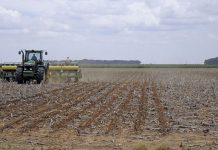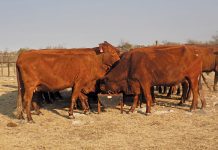Although watermelons prefer warm conditions, you often have to start in cooler conditions to be in production at the right time for market demand. As long as conditions are hot during fruit development, cool weather in the earlier stages does little harm. But maturing into cold is not conducive to good quality. Sunburn can be a problem in hot, dry conditions for dark-coloured varieties, especially if the crop is under drought stress. Varieties like Charleston Gray and Sweet Princess with a light green colour have the best sunburn protection, especially if the vines are growing vigorously and are covering the fruit to some extent. Striped varieties like All Sweet and Crimson Sweet, with a combination of medium and light green skin are also usually safe in our conditions.
Watermelons aren’t too fussy about soil type as long as it’s well-drained. Light loam is generally preferred. Soil with a higher humus content will provide healthier growth and less chance of root rot. The addition of kraal manure will generate a good response. This can be applied to the rows only when in short supply. As with other crops, it’s safer to fertilise according to a soil analysis. The cost of this is negligible compared to dealing with a deficiency later on. Low calcium can cause blossom-end rot and poor fruit quality. Crop rotation will reduce the incidence of Fusarium wilt. If you notice wilt on a crop, extend the planting interval.
Row spacing can be between 1,5m to 3m and will depend on the variety and growing conditions. It’s more important to test the wider spacings when planting expensive seed to see how far you can go before there’s a drop in yield. Wider spacing also makes weed control much easier.Drip irrigation is well-suited to watermelon, but overhead sprinklers are also fine. Drip saves a lot of water and there’s less leaf disease and weed growth. Irrigation practices should be geared towards deep irrigation and a steady supply of water.Dry periods can affect fruit size and shape, but over-irrigation should be avoided at all cost, as this will increase the likelihood of wilt, especially the case with heavier soil. We have several wilt-resistant varieties but this doesn’t mean immunity. Remember there are degrees of resistance. – Bill Kerr ([email protected] or (016) 366 0616). |fw








